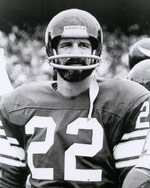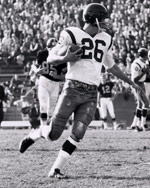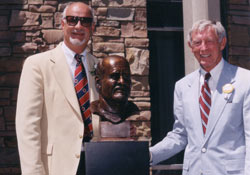Master of his Destiny
 Krause hosted Harley-Davidson Ride-In>>>
Krause hosted Harley-Davidson Ride-In>>>
It’s sometimes said that fate often steps in to dictate the course of human events. That surely seems to have been the case for Paul Krause, who in the early 1960s was an outstanding athlete at the University of Iowa.
Krause, a two-sport star, excelled at both baseball and football. It was, however, in baseball that he first gained significant recognition. A center fielder, Krause was a powerful batter and possessed a terrific throwing arm. "I remember one time playing Bradley University," he said, "I threw four guys out at home plate." In 1962, his first year of varsity baseball at Iowa, 12 major league teams contacted the Flint, Michigan native with offers as high as $50,000 - a large figure for that day. Although the contract offers were tempting, Paul decided to remain in college.
 Unfortunately, during a football game against Michigan the next fall, Paul separated his shoulder. The injury had serious repercussions. "I tried to play baseball my next year," he recalled, "but I couldn’t throw at all." Soon, the major league scouts and their contract offers disappeared.
Unfortunately, during a football game against Michigan the next fall, Paul separated his shoulder. The injury had serious repercussions. "I tried to play baseball my next year," he recalled, "but I couldn’t throw at all." Soon, the major league scouts and their contract offers disappeared.
Rather than blame the seemingly cruel hand of fate, Krause went on to prove that he was still the master of his own destiny. With a baseball career no longer an option, Paul decided to refocus on football.
The 6-2, 200-pound Hawkeye quickly developed into one of the outstanding football players in the Big Ten Conference. As a defensive back he intercepted 12 passes in his final two seasons (1962-1963). On offense, his six touchdown receptions in 1963 were tops in the conference. His outstanding play earned him All-Big Ten honors as a senior. The Washington Redskins, impressed with Krause's athletic ability, selected him with their second round pick in the 1964 National Football League draft.
Former Minnesota Vikings head coach Jerry Burns was Krause’s football coach at Iowa from 1960 to 1963. He was confident that Krause would make it in pro football. "He was drafted primarily as a defensive back and I knew that he had the feel and the range to play defensive back in the pros."
Krause justified his early round selection by having a spectacular rookie season. He began his pro career by pilfering two Frank Ryan passes in the season opener against the Cleveland Browns. One led to a touchdown and the other a field goal. During the next four games he picked off just one pass and at that point began to look like just another good rookie back.
 |
| Krause had 28 interceptions during his four seasons with Washington. |
However, Krause, like the center fielder he once dreamed of becoming, grabbed at least one interception in each of the next seven games. He finished his inaugural season with a league leading 12 steals. For his efforts he was named All-NFL. He was also named to the Pro Bowl and finished second to teammate Charley Taylor for Rookie of the Year honors.
Redskins’ coach Bill McPeak recognized his prize rookie’s potential. "Krause is headed for pro greatness," he said. "He’s fast, his timing is incredible and he hits harder than you’d think from his build."
"The opposing quarterbacks were throwing my way a lot that first year to see what I could do," Krause says. "That was in the years when pro football was changing and quarterbacks were starting to throw more so I saw a lot of balls."
Sam Huff and Sonny Jurgensen warned their rookie teammate not to expect that trend to continue once quarterbacks realized his playing ability. "They were right," Krause later remarked. The fact that quarterbacks stayed away from Krause’s zone was both flattering and frustrating. He never again led the league in interceptions.
Paul spent four seasons with the Redskins. During that time he was named to two consecutive All-NFL teams and hauled in a total of 28 enemy passes. He even saw time on offense in 1965 as an end when injuries to the Redskins’ receiving unit forced McPeak to shift his defensive star to offense for a game against the Pittsburgh Steelers. "Krause has the potential to be one of the better pass receivers in the league," McPeak said following Krause’s offensive debut. Then in 1968, in a surprise move, the Redskins traded Paul to the Vikings for linebacker Marlin McKeever and a seventh round draft choice.
Minnesota’s general manager Jim Finks and head coach Bud Grant both later claimed the deal may have been the best they had ever orchestrated.
"In 1968, we decided to go almost exclusively to the zone, which was a radical change in the league," said Grant. "One of the reasons was our defensive line of Eller, Page, Larsen, and Marshall, all of whom were outstanding pass rushers. What we really needed was an intelligent, far-ranging free safety with great hands, in other words, a super athlete. After surveying the league, we decided that Paul Krause had all those qualities."
Krause played 12 sensational seasons with Minnesota. In his first as a Viking, he intercepted passes in six consecutive games. Three times he led his team in interceptions. His 10 steals in 1975 were an NFC best and is still a Vikings record. His 201 return yardage that year also was tops in the NFL.
But besides interceptions, there are other things a good free safety must do - last second deflections and last ditch tackles - and Paul could always be counted on for both.
"When I got to Minnesota," he recalled, "I was quite fortunate to play a part in a truly great defense. I was never really that great of a defender against the run…my objective in playing the run was to just stop the runner before he reached our goal line."
A cagey player, Paul never took unnecessary risks when in coverage. "I never take a chance," he once offered. "I’ve got to get that man down any way I can. If I take a diving shot at him and miss the tackle, he’s got a touchdown. I go for the interception only when I’m convinced I can get it; if there’s any doubt in my mind I go for the tackle."
Krause’s main chore in Minnesota was to stop the long bomb. The Vikings used a three-deep zone coverage downfield, using the linebackers in the short territory, while freeing three defensive backs deep in an effort to contain receivers. Krause, a master at deception, excelled in the Vikings’ system.
Before each game, Krause would meet with the other members of the secondary and go over their game strategy. Every meeting ended with the enthusiastic chant of "Ban the bomb!"
"We tried to disguise our defense so that the quarterback didn’t know what we would do until the ball was snapped and we moved into it," explained Krause. "I tried to be someplace where he didn’t expect to find a free safety. Positioning was always important to me. I knew how much ground I could cover, and knew how fast I could go."
Krause’s instincts were like a sixth sense. Combined with his remarkable ability to react to given situations, he quickly emerged as one of the most feared safeties in the league. In 1969, Steelers’ quarterback Dick Shiner found out the hard way just how finely honed Krause’s instincts were, when he intercepted a pass and dashed 77 yards for a touchdown. Later in the game Krause again intercepted Shiner, as the Vikings destroyed the Steelers 52-14. His performance won him Associated Press Defensive Player of the Week honors.
"When I play defense I don’t watch a guy’s stomach or anything when he runs at me," Krause once said when describing his technique. "I watch the flow of the whole play. I try to keep everything in front of me - watching the quarterback, the movement of the backs and the flow of the linemen."
Krause’s consistently outstanding play was one of the keys to turning the Vikings into a perennial championship contender. During his 12 seasons with the Vikes, the team played in four Super Bowls (IV, VIII, IX, and XI) and five NFL/NFC Championship games.
Grant said of his star defender: "Paul is what free safety means. He sits back there and sees things happen; has great peripheral vision and gets feelings about plays and quarterbacks. He moves to where the action is without endangering his own responsibilities."
 |
| Krause was inducted into the Hall of Fame in 1998. |
Against the Cleveland Browns in the 1969 NFL Championship Game, Krause demonstrated his big play ability. Early in the third quarter, Cleveland wide receiver Gary Collins was sent on a fly pattern to the end zone. Collins beat cornerback Earsell Mackbee and broke into the open field. Just as Browns’ quarterback Frank Ryan released what looked to be a sure touchdown pass, Krause converged on the scene, cut in front of Collins and sealed the Browns’ fate with a touchdown-stealing interception.
Collins admitted after the game that he never saw Krause. "I knew it was coming," Krause said. "It was third and 12 and they had to go for it. They like to throw to Collins in that case. We were ready for it."
Throughout the first half of the 1970s, Krause dominated his position. He was named All-NFC in 1970, 1971, 1972, 1973, and 1975. He played in six Pro Bowls during the same period. With his 10-interception performance in the 1975 season, Krause ran his career total to 74, just five shy of Hall of Famer Emlen Tunnell’s all-time record of 79 steals.
"Paul had an outstanding year in 1975," Grant remarked. "That is even more impressive when you account that teams avoid the middle because of Krause…He has the experience that is so important back there."
The veteran defensive back added 2 interceptions in both 1976 and 1977. Then in 1978, for the first time in his career, Krause went a full season without intercepting a pass. He was one short of Tunnell’s record. Always in peak condition - Krause, who missed just two games due to injuries in 16 seasons - decided he would play one more season hoping to break the long-held record.
By week 14 of the 1979 season, however, it looked like he might have to settle for tying the record. He’d managed just one interception in the Vikings’ first 13 games. Then on December 2, in a game against the Los Angeles Rams, the 37-year-old Krause picked off quarterback Vince Ferragamo for the record. Later in the same game he intercepted a Bob Lee pass, establishing a new record of 81 career interceptions.
"I was a rookie in 1979," recalled Vikings offensive lineman Dave Huffman, "and Keith Nord and I are standing on the sidelines when Paul runs us over after intercepting the record pass. On the plane coming home Paul leaned over to both of us and said, ‘That football was worth more than both your salaries combined.’"
A few weeks later Paul Krause retired as the most successful pass-stealing free safety in the history of the NFL. In 1998, the man who revolutionized the free safety position was awarded pro football’s ultimate honor when he became just the third Minnesota Vikings player to be elected to the Pro Football Hall of Fame.